This Region of Peru Has Incredible Ancient Ruins — Without Machu Picchu's Crowds
With its centuries-old ruins and striking mountains, the Amazonas region of northern Peru has no shortage of thrills.
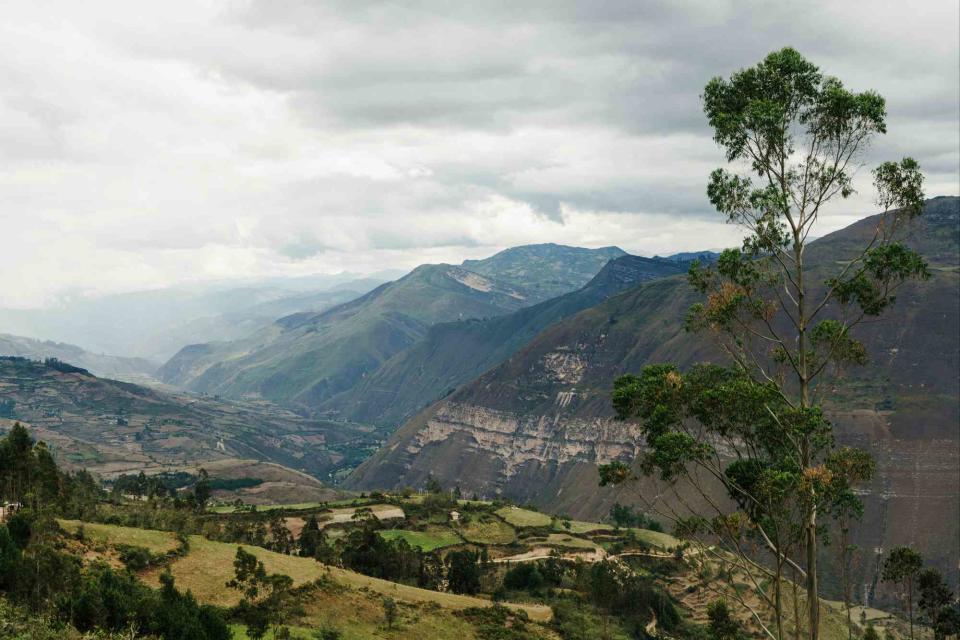
João Canziani
A valley between Leymebamba and Chachapoyas.Over the past few decades, Peru has been trying to weightily designate a number of its archaeological sites as “the next Machu Picchu,” after the famed Incan redoubt in the country’s Sacred Valley. These range from the relatively obscure — like Choquequirao, the “cradle of gold” celebrated as the site of the Incas’ last stand against the Spanish — to somewhat better-known places like Kuélap, a huge, walled mountaintop settlement once populated by the mysterious Chachapoya civilization, the fabled warriors of the cloud forest.
The effort to crown new successors stems as much from the desire to attract adventurous travelers as it does from the need to siphon visitors away from Machu Picchu itself, which, prior to the pandemic, was well on its way to becoming a poster child for overtourism. (The site has gone from fewer than 200,000 visitors a year in 1980 to more than 1.5 million in 2018; by contrast, Choquequirao gets about two days’ worth of Machu visitors over the course of an entire year.) Far more people visit Machu Picchu on an average day than ever lived there; one writer clocked a new #Machu post going up on Instagram every 48 seconds.
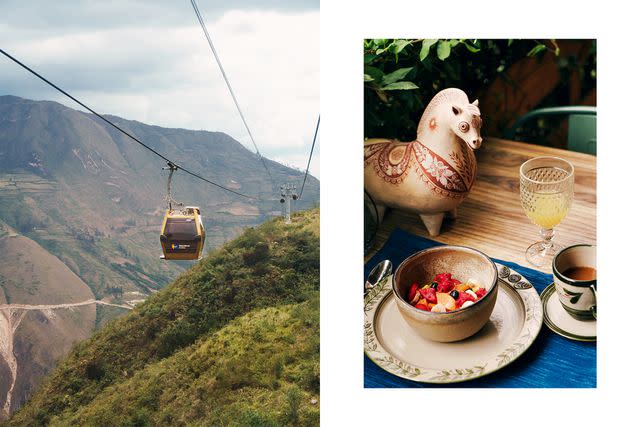
João Canziani
From left: The gondola to the walled settlement at Kuélap; a breakfast of fruit salad at Gocta Natura Reserve.As someone who shies away from crowds, I reveled in the idea of visiting underappreciated archaeological masterworks in comparative solitude. So, a couple of years ago, I began cataloging on Google Earth the myriad Peruvian places I wanted to visit, the country’s riches unfolding at the mere drag of the finger. But when I called Marisol Mosquera, who heads the Lima-based luxury operator Aracari Travel, I got a reality check. There was nothing wrong with my fantasy itinerary, she noted — except that it would take months.
"The opening scene of the 1981 film Raiders of the Lost Ark, in which the swashbuckling archaeologist played by Harrison Ford swaps a bag of sand for a gleaming gold fertility idol, is supposedly set in this part of Peru. The movie wasn’t actually filmed there, but there were moments when we would have been forgiven for thinking we were in the world of Indiana Jones."
In Peru, distances on a map may look short as the quetzal flies, but actually traversing them — often on narrow, vertiginous roads prone to washouts, rockslides, and a startling array of livestock — can be grindingly slow. A site I’d pegged as an easy day trip was, Mosquera told me, a 17-hour drive, one way. Accessing the sites often involves lengthy hikes, and there isn’t much in the way of anything beyond basic accommodations.
But Mosquera said she had grown increasingly keen on the northern region of Amazonas, particularly the area around Chachapoyas. The colonial mountain town was named for the fierce “lost” civilization that had inhabited the “eyebrow of the jungle” from around A.D. 500 to its eventual conquest, first by the Incas in the late 15th century, then by the Spanish in the mid 16th century.
There were a number of sites in Amazonas to visit, most prominently Kuélap, with its massive walls and hundreds of buildings — many still intact. The site was rediscovered in the 1850s but not given serious attention until the late 20th century. And there were two small, stylish inns Mosquera admired — both run by women, both occupying reforested land, and both within striking distance of significant sites.
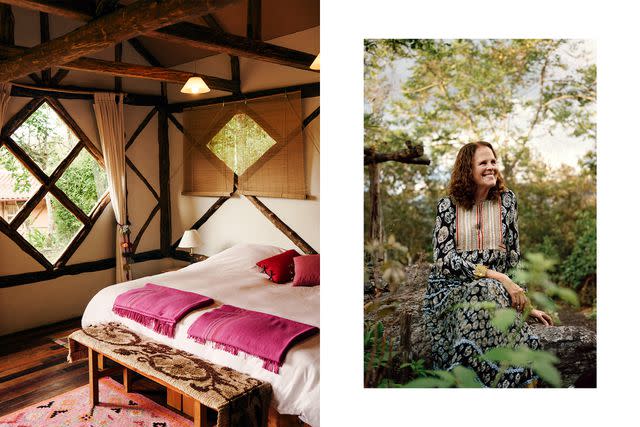
João Canziani
From left: A guest room at Kentitambo; Rocío Florez, owner of Gocta Natura Reserve.The travel plan I hatched immediately encountered headwinds: first, COVID came along; then, I realized I’d forgotten to renew my passport. Finally, I fixed on a week in late April 2022. But dark portents kept appearing. A 7.5 magnitude earthquake struck Amazonas in late 2021, damaging a number of roads. Then, weeks before my departure date, Peru was gripped by political protests, including a strike by transport workers (the country’s episodic bouts of political instability make it worth checking the U.S. State Department website before planning a visit).
Related: I Went On My First Solo Hiking Trip In Peru — Here's How You Can Too
Just when I was days away from setting off, a section of restored wall at Kuélap collapsed, and the government closed the site. Rob Dover, an English-Peruvian dual national who runs Vilaya Tours in Chachapoyas and whom I’d been consulting on my itinerary, suggested I go anyway, for two reasons: first, to draw attention to what many view as the governmental negligence that caused the situation at Kuélap; second, because there were so many other things to see and do.
There was one final hurdle. On the eve of our trip, my brother-in-law Robert, who’d agreed to be my travel partner, revealed that he had a fear of heights. My mind flashed to roads twisting up to the 10,000-foot-high mountaintop pueblos we’d be visiting. “Think of it as exposure therapy,” I joked.
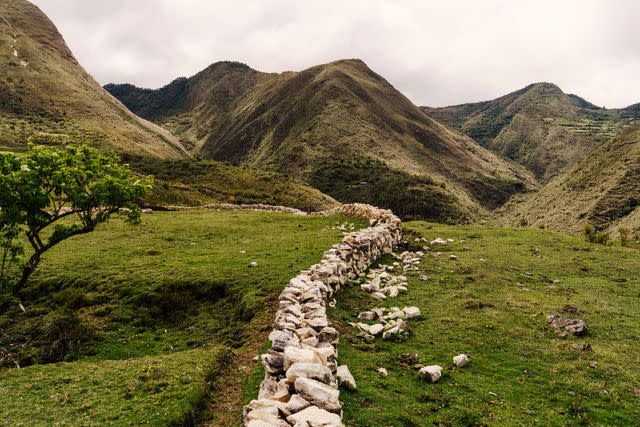
João Canziani
On the trail from La Petaca, a Chachapoyan archaeological site.As I stepped out onto the broad deck of my cabin at the Gocta Natura Reserve, I suddenly had the sensation that I was inhabiting the white noise machine, with its settings of “waterfall,” “stream,” and “rainforest,” that for years helped me sleep amid the commotion of New York City. I stared at the massive Gocta waterfall — at 2,530 feet, one of the world’s tallest — coursing with days’ worth of rain. Its dull roar across the valley was joined by a cacophony of avian life; somewhere in the distance, the Gocta River burbled by.
Gocta Natura is located just outside the small town of Cocachimba, itself about an hour’s drive from Chachapoyas, the region’s biggest city — which almost everyone jauntily calls “Chacha.” A 90-minute flight leaves Lima three times a week for its tiny airport. An increasingly popular hub, Chachapoyas is itself worth an afternoon’s wandering. This pleasant mountain town has a university and cobblestoned streets lined with whitewashed buildings accented by Bavarian-looking dark wood details.
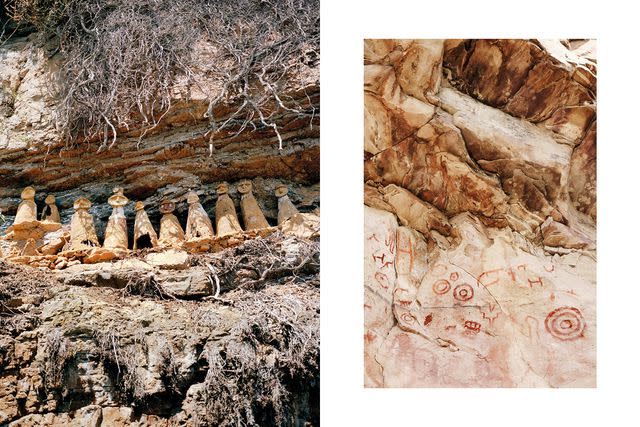
João Canziani
From left: Sarcophagi at Cerro el Tigre, a cliffside Chachapoyan burial ground; pictographs at the Cambolín archaeological site.After a brief stop at Huancas, a tiny hilltop village with a transfixing view onto the magnificent Sonche Canyon, we headed to Gocta Natura. The six-cabin eco-lodge began life as a second home for Rocío Florez, who was working for the World Bank in Lima when she and her husband visited the area in the early 2000s. They were captivated, and bought a piece of farmland.
Related: Peru's Rainbow Mountain Is An Incredible Display of Color — Here's How to Visit
In 2002, a German engineer measured the falls, then mostly a local secret, and declared them the world’s third tallest. The claim has since been revised downward, but the falls, which descend in two stages, with the top split into two channels, are undeniably impressive — and thus a nascent tourism industry was born. A dirt road was built, and a few small guesthouses opened. Florez, envisioning a “productive retirement,” began building her cabins and planting trees. An expert in sustainable development, she worked from the beginning on statutes intended to lessen the negative effects of tourism. “Some of the younger generation has been returning to Cocachimba,” she said, lured by the burgeoning economy.
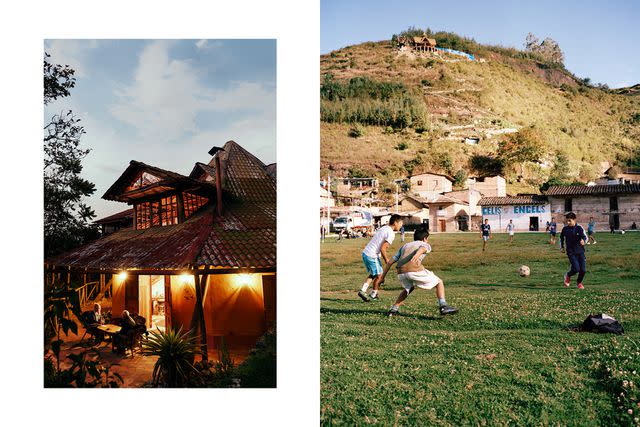
João Canziani
From left: Evening at Kentitambo; a soccer game in Dos de Mayo, a village near Leymebamba.Cocachimba, thankfully, still seems quite sleepy. As Robert and I departed at 7 a.m. for the roughly eight-mile round-trip hike to the falls (some visitors go on horseback), a pair of young Danes were the only visitors we encountered. The path, sometimes manicured with paving stones, sometimes a muddy track, wound through thick cloud forests and was dotted with mosses, ferns, and bromeliads. A few small, shuttered huts advertised cold drinks. A little white dog joined us, bounding ahead to each bend and looking back expectantly. We named him Jefe.
"Arriving at the base of the falls, we were suddenly in a glistening emerald wonderland. Because the waterfall is so high, it’s mostly mist by the time it reaches the bottom, but the sheer force of the vapor radiates outward in strong, cooling waves."
Arriving at the base of the falls, we were suddenly in a glistening emerald wonderland. Because the waterfall is so high, it’s mostly mist by the time it reaches the bottom, but the sheer force of the vapor radiates outward in strong, cooling waves. I’ve been at waterfalls a fraction of the size that were thronged with selfie-taking hordes; here, we were completely alone. There was no sign of the sirena — a sort of mermaid — that some locals believe inhabits it.
Returning, we began to encounter more people, mostly day-trippers from Chachapoyas. At Gocta, lunch awaited, one of three daily meals the lodge provides — part of an ambitious food program overseen by Florez’s son Matías Cillóniz, who also runs a bistro in Lima. Much of the food served, including Amazonas fruits like cherimoya and passion fruit, is grown on the property. Other menu standouts, like Andean black potatoes — one of Peru’s 4,000-plus endemic species of potato — are sourced from a group of women farmers in a nearby hilltop village.
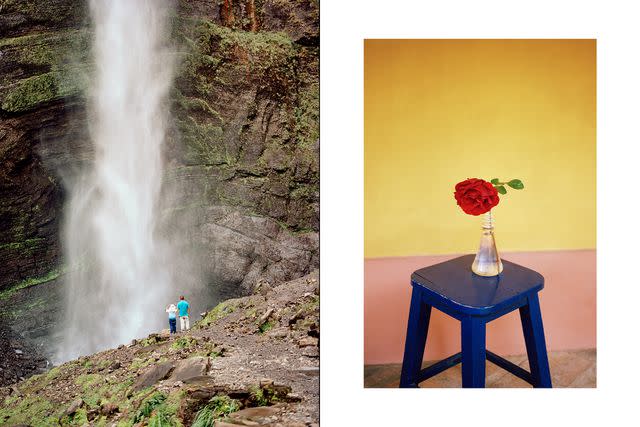
João Canziani
From left: Northern Peru's Gocta waterfall, one of the world's tallest at more than 2,500 feet; simplicity reigns at Kentitambo, a lodge in the cloud-forest town of Leymebamba.Florez is trying to bring a new level of hospitality to Cocachimba. “I’ve just trained two ladies who’ve worked with me for years to do massages,” she told us. With excursions often requiring lengthy drives, she’s trying to make Gocta itself a more alluring destination. “The idea is, after a strenuous but beautiful activity, you come back and are pampered.”
One late afternoon, refreshed by a cooling chilcano de pisco cocktail, we walked to town to visit a hummingbird refuge recently opened by Elmer Yalta, the owner of a small hotel whose livelihood was derailed during COVID. Having inherited a chunk of land on the edge of town from his father, he stumbled upon the colibri cola de espátula, an endangered species of bird famed for its drooping, two-pronged tail. Yalta’s pandemic pivot was to convert the agricultural land into a forest stocked with hummingbird-friendly flora. Sitting in a shed, staring at a group of feeders, we watched as the bird suddenly appeared and probed its beak into the feeder, its beautiful, preposterous appendage hovering like some phantom twin. Yalta’s experience seemed emblematic of tourism itself: plant the right amenities, and people will come. But be sure to do it carefully, because ecosystems are fragile.
"I had been virtually alone among the remnants of a thousand-year-old tomb built 3,000 feet above the village. It’s increasingly a rarity to come across such an unmediated, little-visited, remarkable place."
The opening scene of the 1981 film Raiders of the Lost Ark, in which the swashbuckling archaeologist played by Harrison Ford swaps a bag of sand for a gleaming gold fertility idol, is supposedly set in this part of Peru. The movie wasn’t actually filmed there, but there were moments when we would have been forgiven for thinking we were in the world of Indiana Jones. One day I took a nearly two-hour taxi ride to the small village of San Jerónimo to see Cerro el Tigre, a set of cliffside Chachapoyan sarcophagi discovered by a local shepherd in 2013. Robert, as if sensing what was coming, opted to stay at Natura, enjoying a book and the waterfall view. And good thing: even the road to the village was near-nosebleed territory.
As at many sites in Peru, access is gained via someone in the local community, in this case the cashier at a small grocery, who asked me to sign a guest book — the last visitors had been weeks before. She then took my money: 10 soles, a little less than $3, for the entrance fee and 50 soles, about $13, for the guide, a 16-year-old girl named Annali. Wearing a colorful sweater and a pair of Wellingtons, Annali nonchalantly led me and my driver, Elvis Hernández — who, having never seen the site, invited himself along — down a track to Cerro el Tigre.

João Canziani
From left: Horses roam near the road to La Petaca archaeological site; on the trail to the Cerro el Tigre sarcophagi with guide Juan Santillan.We walked through a pasture, passing cows and dragon-fruit orchards, while a huge, sheer rock face loomed in the distance. After crossing a small waterfall, the butterfly-populated path twisted up a series of tight switchbacks into dense cloud forest. We scrambled up muddy sections and gingerly crossed handmade wooden bridges slick with moisture, finally emerging onto a high ledge marked by the remains of houses, bits of pottery, and, startlingly, a collection of human skulls arrayed on a rock.
More Trip Ideas: Visit Mayan Ruins, White-sand Beaches, and Lush Rain Forest in Mexico's Next Ecotourism Destination
I was still trying to figure out where the sarcophagi were when Annali gestured toward a bridge made of hand-hewn logs. At the end was a ladder — a set of planks, really — nailed to a large tree jutting out into space. I nervously ascended what felt like a homespun tree house from my 1970s suburban youth. Reaching the top, I slowly turned around.

João Canziani
From left: Azelita Portal holds blooms from the farm at Kentitambo Lodge; flowers in the Mercado Modelo, an open-air market in the city of Chachapoyas.What I saw struck me with some weird primal power: a row of small figures with rounded, earthen bodies, arrayed under an outcropping of rock like Kewpie dolls at a country fair. Their smooth, oval faces, with simple painted eyes cast in shadow by prominent sculpted foreheads, stared silently out, for all time, across the Peruvian altiplano. Closer inspection revealed holes in the sides of the sarcophagi where the human remains had been looted. I took all this in, then made the mistake of looking down. A sheer drop, only partially obscured by dense jungle.
Cerro el Tigre isn’t for everyone: the viewing platform isn’t built to any recognizable safety code, and just getting there is an endeavor. At one point, Elvis and I had to help a truck driver who had stopped ahead of us move several huge boulders out of the road. But the thrill of real, unadulterated adventure was undeniable. I had been virtually alone among the remnants of a thousand-year-old tomb built 3,000 feet above the village. It’s increasingly a rarity to come across such an unmediated, little-visited, remarkable place. And yet, the people of this region would no doubt benefit if Cerro el Tigre became better known, which would bring more visitors to spend money in local villages.
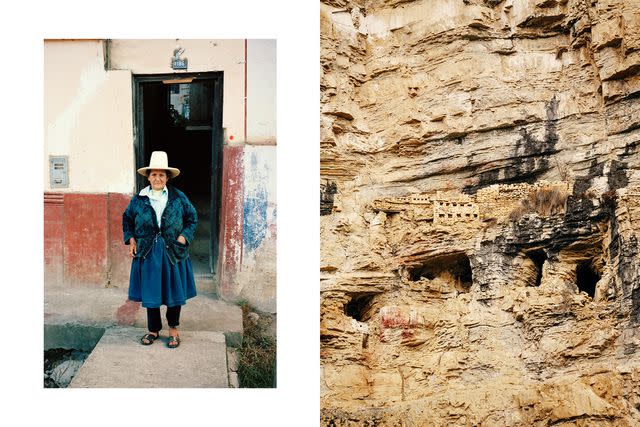
João Canziani
From left: Petronila Rodriguez Zelada, a resident of Dos de Mayo; ancient mausoleums built into the side of a cliff at La Petaca.Moments like these kept cropping up. On another afternoon, Robert and I traveled to a new archaeological site near Chachapoyas, a mountaintop settlement known as Cambolín. We were greeted at the windswept summit — unusually, it was easily reachable by car — by Jeff Contreras Soto, an archaeologist, and Amado Lopez, a community member from San Juan de Sonche, the town that oversees visits to the site as well as a nearby zipline and waterfall. Lopez offered a plastic bag of coca leaves, a common remedy against hypoxia. Feeling the altitude, we indulged (placebo or not, it seemed to do the trick).
Thus steadied, we toured the complex with Contreras Soto as he pointed out the rare, still-intact mortar between the stones of the circular houses — a hallmark of Chachapoyan architecture — or pictographs with red target-like motifs. I had been told by Brown University archaeologist Parker Van Valkenburg that rather than a single culture, the Chachapoya were more likely a “mosaic of smaller polities that may have banded together” against Incan imperialism. The presence at Cambolín of square-shaped buildings — an Incan staple — revealed the seeming failure of that strategy.
Related: 25 Best Places to Visit In South America
Will Cambolín be the next Machu Picchu? No. But we were alone, with an archaeologist, for a two-hour visit at a significant, active site that is still being interpreted. Afterward we were taken, along with some students working on the site, to the small town below for a lunch in the community hall served by local women wearing traditional outfits, where we were plied with a further succession of regional elixirs.
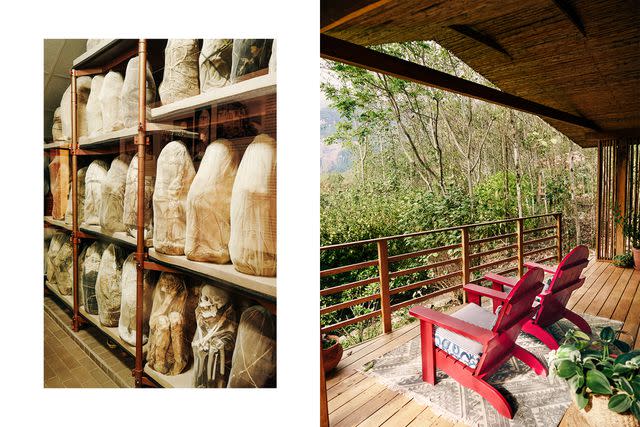
João Canziani
From left: Mummies at Leymebamba Museum; the patio of the Tanager cabin at Gocta.“I’ve never seen a culture that has so many ways of burying their dead,” Adriana von Hagen told us over dinner at Kentitambo, the small inn she runs with her partner, Oscar Bravo, outside the town of Leymebamba. There were the aboveground tombs known as chullpas; the cliffside sarcophagi for VIPs; the cave burials. “The walls of Kuélap,” she noted, “are great big cemeteries,” with every nook and cranny used to stash human bones.
Von Hagen, who trained as an archaeologist and is the daughter of noted American explorer-author Victor von Hagen, is a cofounder of the Leymebamba Museum, located just across the road from the inn. It opened in 2000 on the heels of a momentous discovery of Chachapoyan mummies, near a site called Laguna de Los Cóndores — a grueling three-day horseback ride from Kentitambo.
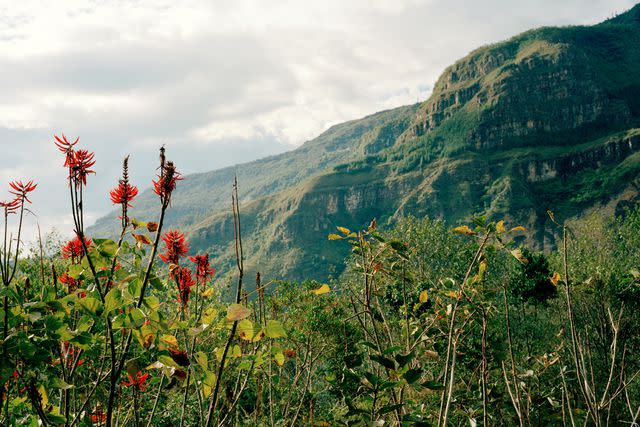
João Canziani
The view from the main lodge of Gocta Natura Reserve.“At first we thought we could do on-site conservation,” she said. But the risk of additional looting was too great. With private funding, a museum was built to house the collection. It’s a fascinating place that, like seemingly everything else, we’d had to ourselves when we visited earlier that day. We peered through glass to look at the conserved mummies, crouched in an almost fetal position, their faces looking frozen in anguish. (It was Edvard Munch’s viewing of Chachapoyan mummies at the 1899 Trocadero Exposition in Paris that inspired The Scream.) Among other artifacts, the museum has an extensive collection of quipus, the knotted strings that the Incas used as a kind of number-crunching device.
"We unpacked a picnic lunch and pored over the tombs and pictographs with binoculars, reveling again at our sense of being alone in the company of these haunting monuments. "
Sitting at the table at Kentitambo is like being privy to some archaeological salon, with von Hagen offering tart opinions on overtourism in the Sacred Valley or the lack of attention paid by the government to Kuélap (“it’s been in scaffolding for years”). Bravo, meanwhile, chimes in with a joke and a hearty laugh. The inn is a favorite haunt not just for archaeologists but naturalists of all stripes. (A couple from Michigan, regular guests who are keen lepidopterists, were credited with finding a new butterfly species in the area.) It’s a bit more rustic than Gocta, the food more home-cooked. The climate is a bit wetter, a bit cooler. Befitting its sobriquet as the “hummingbird inn,” its grounds are packed with flora and fauna — I saw the spatula-tailed hummingbird, so rare in Cocachimba, right from my breakfast chair.
More Trip Ideas: How to Travel to Patagonia
Kentitambo is also close to a range of stunning archaeological sites. After our two-hour visit to the Leymebamba Museum, we were taken by Segundo “Viejo” Aguilar, a guide, to a site called La Petaca. We drove for an hour south, and disembarked at the beginning of a cattle trail. It had been raining, and walking was a delicate balance between trying not to lose a rubber boot in the sucking mud and trying not to fall down. We wound through a verdant pastoral landscape that could have been Scotland, then climbed a hill that briefly gave Robert pause — with urging from Viejo, he soldiered on — until we reached a plateau thick with bracken.

João Canziani
From left: A fruit stall at the Mercado Modelo; a family relaxes in Dos de Mayo.Viejo hacked a path with his machete, and we suddenly had a view of a towering rock face. We could see, with the naked eye, mausoleums carved into the cliff. Contemporary archaeologists have explored those spaces using modern climbing equipment to rappel down the sheer cliff face, making it even more astonishing that the Chachapoya were working in this environment a thousand years ago. We unpacked a picnic lunch and pored over the tombs and pictographs with binoculars, reveling again at our sense of being alone in the company of these haunting monuments.
Amazonas is not the easiest place to travel to. It takes a while to get places, and you may have to help your driver clear a path through a washed-out road. On a hike to a site, it’s always further than you think. Bravo, at Kentitambo, used the slang word allishito — meaning, in essence, just a little bit more over there. But when you get to wherever there is, you’ll be convinced that the journey was worth the effort.
Where to Stay
Gocta Natura Reserve: Onetime Lima resident Rocío Florez hosts visitors at six stylishly rustic cabins (ask for one with a view of the stunning Gocta waterfall, a half-day’s hike away) in the hamlet of Cocachimba, while her son Matías Cillóniz oversees a food program supplied by the on-site gardens.
Kentitambo: Run by archaeologist Adriana von Hagen, Kentitambo is a small inn set among verdant cloud-forest foliage and surrounded by hummingbirds, in the small town of Leymebamba. The namesake museum, just across the road, is home to a famous collection of mummies.
How to Book
Aracari Travel: Peru is a large country, and the logistics can be tricky. Marisol Mosquera (travel@aracari.com) can arrange trips to any of the sites mentioned in this article (including the now partially reopened ruins of Kuélap).
Vilaya Tours: Rob Dover, an Englishman who has lived in Peru for decades, is an expert on the Chachapoyas region and offers a wide array of outings, including longer jungle treks and horseback journeys.
A version of this story first appeared in the December 2023/January 2024 issue of Travel + Leisure under the headline "The Height of Adventure."
For more Travel & Leisure news, make sure to sign up for our newsletter!
Read the original article on Travel & Leisure.

